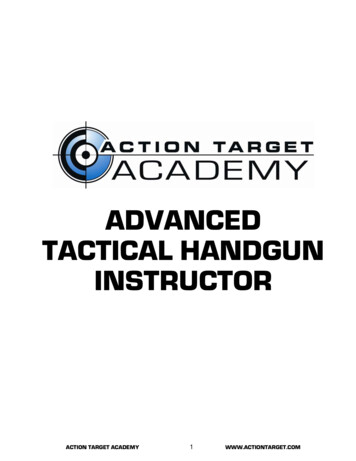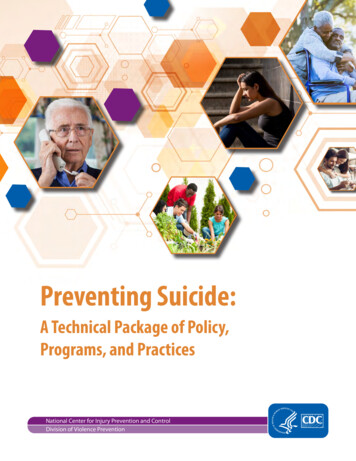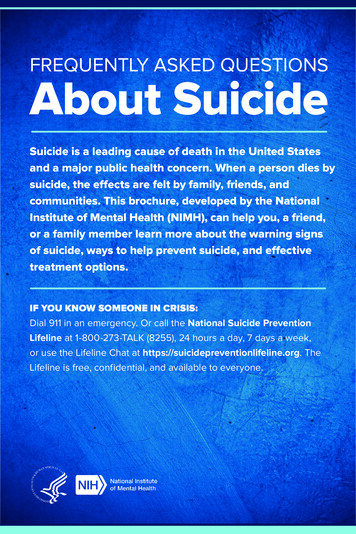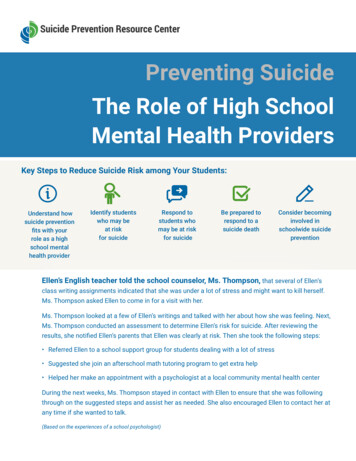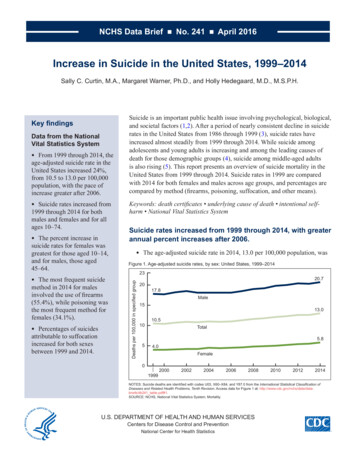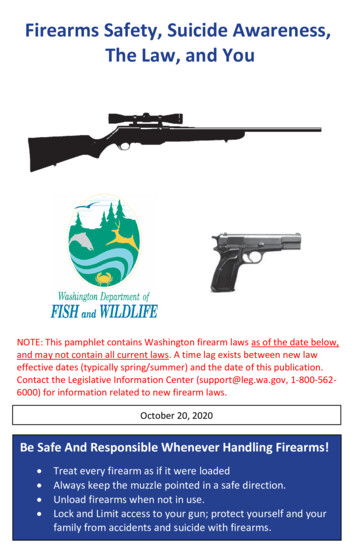
Transcription
Firearms Safety, Suicide Awareness,The Law, and YouNOTE: This pamphlet contains Washington firearm laws as of the date below,and may not contain all current laws. A time lag exists between new laweffective dates (typically spring/summer) and the date of this publication.Contact the Legislative Information Center (support@leg.wa.gov, 1-800-5626000) for information related to new firearm laws.October 20, 2020Be Safe And Responsible Whenever Handling Firearms! Treat every firearm as if it were loadedAlways keep the muzzle pointed in a safe direction.Unload firearms when not in use.Lock and Limit access to your gun; protect yourself and yourfamily from accidents and suicide with firearms.
(This page intentionally left blank.)2
Suicide AwarenessWashington hunters take their firearm safety seriously. They work at it– and the decrease in hunting accidents shows the results of this hardwork. If firearm owners take this same serious approach to firearmsecurity and suicide prevention, a similar result will occur. We trulyneed your understanding and support to reduce firearm suicide.Many people do not realize that 78 percent of Washington firearmdeaths from 2005 to2015 were suicides. Firearms are the mostfrequently used method in suicides in the U.S. For young people ages10-18, most suicides and suicide attempts involve two things that areeasily accessible in the home – firearms and prescription medications.The Washington Department of Fish & Wildlife (WDFW) publishes thispamphlet as per state law (RCW 9.41.310). Firearms are owned formany purposes (hunting, target shooting, collecting, personal or homedefense, etc.). WDFW’s Hunter Education Program is pleased topresent basic information not only on firearm safety but also onsuicide awareness and prevention.Do Young People Live in or Visit Your Home? LOCK UP: For their protection, do not allow children & teensunsupervised, unauthorized access to firearms.LIMIT: Only the firearm owner or designee should have accessto keys and combinations.CHOOSE: Carefully select a safe storage device for homedefense firearms with fast access for only you.Concerned about yourself, friend, or family member? HOLD: Give a trusted individual keys and combinations.TRANSFER: Ask someone to hold firearms with an emergencytransferCALL: National Suicide Prevention Lifeline3
Many suicides are preventable. Using the Forefront LEARN steps willhelp support a person who is in emotional distress and consideringsuicide.L: LOOK FOR WARNING SIGNS Hopelessness, depression, anxiety, social withdrawal, isolation,divorce, loss of relationship, increasing alcohol or drug use, sleepdisturbances, other loss, rejection or humiliation, feeling like aburden to others, giving away possessions, transitioning frommilitary, talking about deathE: EMPATHIZE AND LISTEN Remain calm Offer care and compassion (“This must be so hard for you.”) Avoid judgement or advice Listen more than you talk (Can you tell me more?”)A: ASK DIRECTLY ABOUT SUICIDE If you recognize warning signs, ask about suicide. Using the word “suicide’ will not put the idea in their mind Be prepared to hear “yes.”R: REMOVE THE DANGER Acknowledge their pain Help to remove access to firearms, alcohol, drugs, medications,belts, ropes, plastic bags, knives, car keys and poisons.N: NEXT LEVEL OF CARE Call 800-273-8255, the National Suicide Prevention Lifeline (24/7).Veterans, press 1. Ideally, call together with the individual at risk. Crisis Text Line (24/7) – 741-741 Crisis.Chat.org Immediate danger? Call 911. Stay with the person.www.SaferHomesCoalition.org4
Firearm SafetyWhen a pilot flies a plane, he or she is the only one who controls theplane’s safety. In the same way, firearms safety is up to you. Whenyou pick up a firearm, you and only you have complete control tomake the system safe. Include in your budget for the purchase of anew firearm, a budget for a safe storage device that will work for you.To learn more about firearms safety, contact your police or countysheriff, a sporting goods store, or gun shop. The WashingtonDepartment of Fish and Wildlife offers classes and online training onhunter education which include firearms safety and handling. Take acourse that also includes content on suicide prevention. Be sure tocheck with local sports clubs to learn about ranges and safe shootingareas you can use.Home SafetyMany Washington residents own firearms. Whether used for hunting,target shooting or home defense, all firearms are potentiallydangerous if handled carelessly. It is especially important to payattention to firearms stored around families and friends. Mediareports draw attention to accidental shooting deaths. However,suicide accounts for 78 percent of Washington firearm deaths. Suicideis the single leading cause of death among Washington youth ages 1524.Secure storage of firearms, as well as medications, is the mosteffective way to protect you, your family and friends from suicide.Think of these tips as general firearms safety rules: Learn basic firearm safety by taking a class with others in yourhousehold. Handle and maintain firearms in a safe and proper manner at alltimes. Always point the muzzle in a safe direction. Always check the action to see if the chamber or cylinder is loaded. Keep your finger away from the trigger unless you are actuallyshooting.5
Never leave a loaded firearm unattended. Store guns unloadedand locked. Be especially careful while cleaning firearms. Far too many“unloaded” guns injure owners or family members. Prevent theft by storing firearms in a secure area while you’reaway from home. View a suicide awareness training. Locking and limiting access tofirearms (and medications) is one of the most effective ways toprevent a suicide. You can find a training atSaferHomesCoalition.org.Washington Department of Fish and Wildlife Hunter EducationHunter education certification is required, with some exceptions, inorder for persons born after January 1, 1972 to purchase their firstWashington hunting license. To receive a basic hunter educationcertification, students must pass a written test and a field skillsevaluation.Washington’s Hunter Education Program curriculum focuses on threebroad topical areas:1) Firearms and hunting safety;2) Hunter responsibility and ethics; and,3) Wildlife management.The Washington Department of Fish and Wildlife offers two types ofhunter education courses that go over firearms and outdoor safety,wildlife management, and hunter responsibility. The traditional course is a multi-day instructor led trainingconsisting of between 10 and 20 hours of instruction. Thisformat is recommended for young students and people seekinga classroom experience. The online course is a two-part course. The online class is astudent driven interactive web tool teaching the same contentas the traditional course. After successfully completing theonline class, students must complete a four-hour field skillsevaluation class with certified instructors.6
Each year, approximately 11,000 students enroll in the program,administered by the Washington Department of Fish and Wildlife(WDFW). Volunteer instructors certified by WDFW teach classes inlocations around the state.Classes in basic hunter education are in high demand in late summerand fall. Classes fill up rapidly, so students are highly encouraged tosign up early to avoid missing an upcoming hunting season.In addition to basic hunter education, WDFW offers certification intrapper education and bowhunter education.For more information on Hunter Education, please visit our ce officer or military exemptionsQualifying peace officers and military personnel may be exempt fromthe firearms field skills portion of the online course. For moreinformation on who may qualify for the exemptions please ation/exemptions.Hunter Education DeferralFirst-time hunters who would like to try the sport can defer the HunterEducation training requirement for one year to hunt with an adult whohas held a Washington hunting license for the previous three years.The deferral is restricted to beginning hunters at least 10 years old andmay be used only once in a person’s lifetime. A 20 application fee isrequired.For more information on the Hunter Education deferral, please visitour website: http://wdfw.wa.gov/hunting/huntered/he deferral.html7
Ten Basic Safety Rules1. Treat every firearm as if it were loaded.2. Keep your finger off the trigger until ready to fire. Use your safety,but remember that safeties sometimes fail.3. Be sure of your target and what lies beyond before firing.4. Never place or carry a loaded firearm in a motor vehicle.5. Never use a firearm unless you are familiar with how it works. Ifyou need an owner’s manual, write to the manufacturer.6. Be sure the barrel and action are clear of obstructions.7. Never cross a fence, climb a tree, cross a stream or jump a ditchwith a loaded firearm.8. Never point at anything you do not want to shoot.9. Unload firearms when not in use. Store firearms and ammunitionseparately.10. Never use alcohol (or drugs) before or during shooting.Target shooting on public landsThe Washington Department of Fish and Wildlife (WDFW) strives to providea positive recreational experience for all outdoor enthusiasts at our wildlifeareas across the state. As the number of people recreating on public landsincreases each year, it is important for all users to have an extra level ofawareness. If you target shoot on public lands, follow target shooting bestpractices to enjoy safe and responsible recreation.Know before you shoot!Follow these guidelines to protect public safety and habitat, and prevent firerisk on public lands. Practice target shooting only in areas with an unobstructed, earthenbackstop that can safely stop all projectiles and debris.8
Do not target shoot while under the influence of drugs or alcohol.Do not shoot within 500 feet of a recreation site or across, along, ordown roads or trails.Unless otherwise posted, do not engage in target shooting half hourafter sunset to half hour before sunrise.Shoot at approved targets – do not shoot at trees, glass, appliances,electronics, furniture, vehicles, signs, or built structures (e.g.buildings, fences, gates, power poles).Do not destroy plants or natural formations.Be aware of your surroundings, especially what lies beyond yourtarget and backdrop. Public lands are used by many types ofrecreationists.Pack out what you pack in (shell casings, targets, and other debris).Speak up if you see a problem!Contact WDFW Enforcement at 1-877-933-9847 to report a violation orsafety concern or Report an incident in-progress by calling 9-1-1.Where to go target shooting in WashingtonWDFW Wildlife Areas - www.wdfw.wa.govMost wildlife areas are open to dispersed target shooting, but it is importantto find a location that complies with state and local laws. Several wildlifeareas across the state have designated shooting ranges or improved sites,including the Methow, Asotin Creek, and Wooten wildlife areas. Contact theWDFW Wildlife Program for more information at 360-902-2515 orwildthing@dfw.wa.gov.Department of Natural Resources (DNR) Lands - www.dnr.wa.govThe majority of DNR-managed lands are open to target shooting inareas that have an unobstructed backstop that can safely stop allprojectiles and debris. Some areas may be designated or posted as noshooting to ensure public safety. Target shooters are encouraged tocontact a DNR regional office for more information.U.S. Forest Service (USFS) Lands in Washington - www.fs.usda.govThe USFS, under direction of the U.S. Department of Agriculture,manages land such as the Gifford Pinchot and Okanogan-WenatcheeNational Forests. Target shooting is allowed on national forest landsunless a specific area has been closed for public safety reasons. There9
are no designated recreation target shooting areas on USFS lands inWashington.Bureau of Land Management (BLM) Lands in Washington www.blm.gov/oregon-washingtonThe BLM is a federal agency within the U.S. Department of Interior.Most land managed by BLM allows target shooting as long as youfollow federal, state, and local laws. Call your local field office for moreinformation.Commercial Shooting RangesTarget shooters can visit a variety of indoor and outdoor shooting ranges inWashington and help support local businesses. To find a range near t.orgwww.shooting.orgFirearm LawsBoth state and federal laws govern firearms use. The basic state codefor Washington is included in this pamphlet. Many federal laws andregulations are listed in the U.S. Code. These two sources are not allinclusive; additional restrictions can apply.For instance, in airports the Federal Aviation Administration prohibitsfirearms in certain restricted areas on or about a person or accessibleproperty (such as carry-on luggage). No private citizen – not even witha concealed pistol license – is exempt from this restriction.Cities, counties, and municipalities in Washington may not enactfirearms laws and ordinances unless authorized by state law. It is yourresponsibility as a firearm owner to know applicable firearm laws andregulations. Remember, no single pamphlet can list all safetyinformation, laws, rules, and regulations.10
Chapter 9.41 RCWFIREARMS AND DANGEROUS WEAPONSRCW Sections9.41.010 Terms defined. 149.41.040 Unlawful possession of firearms—Ownership, possession by certainpersons—Restoration of right to possess—Penalties. . 189.41.042 Children—Permissible firearm possession. . 219.41.045 Offenders under supervision of the department—Possessionprohibited—Penalties. 219.41.047 Persons found not guilty by reason of insanity and others—Possession rights. . 229.41.049 Persons who present likelihood of serious harm—Possession rights. 249.41.050 Carrying firearms. . 249.41.060 Exceptions to restrictions on carrying firearms. . 259.41.065 Correctional employees—Effect of exemption from firearmsrestrictions—Liability limited. . 269.41.070 Concealed pistol license—Application—Fee—Renewal. . 269.41.070 Concealed pistol license—Application—Fee—Renewal. . 319.41.073 Concealed pistol license—Reciprocity. 359.41.075 Concealed pistol license—Revocation. 369.41.080 Delivery to ineligible persons. . 379.41.090 Dealer deliveries regulated—Hold on delivery—Fees authorized.379.41.092 Licensed dealer deliveries—Background checks. . 449.41.094 Waiver of confidentiality. . 449.41.097 Supplying information on the eligibility of persons to possessfirearms, purchase a pistol or semiautomatic assault rifle, or be issued aconcealed pistol license. . 459.41.0975 Officials and agencies—Immunity, writ of mandamus. . 459.41.098 Forfeiture of firearms—Disposition—Confiscation. . 469.41.100 Dealer licensing and registration required. . 489.41.110 Dealer's licenses, by whom granted, conditions, fees—Employees,fingerprinting and background checks—Wholesale sales excepted—Permitsprohibited. . 489.41.111 Firearm frames or receivers—Background check—Penalty. 509.41.113 Firearm sales or transfers—Background checks—Requirements—Exceptions. 519.41.1135 Firearms sales or transfers—Use of state firearms backgroundcheck system. . 5311
9.41.114 Firearm sales or transfers—Denial of application report—Dealer'sduties. . 549.41.115 Penalties—Violations of RCW 9.41.113. 559.41.120 Firearms as loan security. . 559.41.122 Out-of-state purchasing. . 559.41.124 Purchasing of rifles and shotguns by nonresidents. . 559.41.129 Recordkeeping requirements. . 569.41.135 Verification of licenses and registration—Notice to federalgovernment. . 569.41.137 Department of licensing, authority to adopt rules—Reporting ofviolations—Authority to revoke licenses. . 569.41.139 Department of licensing—Eligibility to possess firearms. . 579.41.140 Alteration of identifying marks—Exceptions. 579.41.171 Alien possession of firearms—Requirements—Penalty. 579.41.173 Alien possession of firearms—Alien firearm license—Politicalsubdivisions may not modify requirements—Penalty for false statement.579.41.175 Alien possession of firearms—Possession without license—Conditions. 599.41.185 Coyote getters. . 609.41.190 Unlawful firearms—Exceptions. . 609.41.220 Unlawful firearms and parts contraband. . 619.41.225 Use of machine gun or bump-fire stock in felony—Penalty. . 619.41.230 Aiming or discharging firearms, dangerous weapons. . 629.41.240 Possession of pistol or semiautomatic assault rifle by person fromeighteen to twenty-one. . 629.41.250 Dangerous weapons—Penalty. . 639.41.251 Dangerous weapons—Application of restrictions to lawenforcement, firefighting, rescue, and military personnel. . 639.41.260 Dangerous exhibitions. . 649.41.270 Weapons apparently capable of producing bodily harm—Unlawfulcarrying or handling—Penalty—Exceptions. . 649.41.280 Possessing dangerous weapons on school facilities—Penalty—Exceptions. 659.41.282 Possessing dangerous weapons on child care premises—Penalty—Exceptions. 679.41.290 State preemption. . 689.41.300 Weapons prohibited in certain places—Local laws and ordinances—Exceptions—Penalty. . 699.41.310 Information pamphlet. . 729.41.320 Fireworks. . 7212
9.41.325 Undetectable or untraceable firearms—Penalties. 729.41.330 Felony firearm offenders—Determination of registration. 729.41.333 Duty to register—Requirements. . 739.41.335 Failure to register as felony firearm offender. . 749.41.340 Return of privately owned firearm by law enforcement agency—Notification to family or household member—Exception—Exemption frompublic disclosure—Civil liability—Liability for request based on falseinformation. . 749.41.345 Return of privately owned firearm or concealed pistol license bylaw enforcement agency—Duties—Notice—Exception. . 759.41.350 Voluntary waiver of firearm rights—Procedure—Penalty—Exemption from public disclosure. . 769.41.352 Voluntary waiver of firearm rights—Form—Availability. 779.41.360 Unsafe storage of a firearm. . 779.41.365 Firearm security and storage—Requirements for dealers. . 789.41.800 Surrender of weapons or licenses—Prohibition on future possessionor licensing. 799.41.801 Surrender of weapons or licenses—Ensuring compliance. . 819.41.802 Proof of surrender and receipt pattern form—Declaration ofnonsurrender pattern form—Administrative office of the courts to develop. 849.41.804 Proof of surrender and receipt form, declaration of nonsurrenderform—Requirement to file with clerk of the court. . 849.41.810 Penalty. . 849A.56.310 Possessing a stolen firearm. . 8477.15.460 Loaded rifle or shotgun in vehicle—Unlawful use or possession—Unlawful use of a loaded firearm—Penalty. . 8513
9.41.010Terms defined.Unless the context clearly requires otherwise, the definitions in this sectionapply throughout this chapter.(1) "Antique firearm" means a firearm or replica of a firearm not designed orredesigned for using rim fire or conventional center fire ignition with fixedammunition and manufactured in or before 1898, including any matchlock, flintlock,percussion cap, or similar type of ignition system and also any firearm using fixedammunition manufactured in or before 1898, for which ammunition is no longermanufactured in the United States and is not readily available in the ordinarychannels of commercial trade.(2) "Barrel length" means the distance from the bolt face of a closed actiondown the length of the axis of the bore to the crown of the muzzle, or in the case ofa barrel with attachments to the end of any legal device permanently attached tothe end of the muzzle.(3) "Bump-fire stock" means a butt stock designed to be attached to asemiautomatic firearm with the effect of increasing the rate of fire achievable withthe semiautomatic firearm to that of a fully automatic firearm by using the energyfrom the recoil of the firearm to generate reciprocating action that facilitatesrepeated activation of the trigger.(4) "Crime of violence" means:(a) Any of the following felonies, as now existing or hereafter amended: Anyfelony defined under any law as a class A felony or an attempt to commit a class Afelony, criminal solicitation of or criminal conspiracy to commit a class A felony,manslaughter in the first degree, manslaughter in the second degree, indecentliberties if committed by forcible compulsion, kidnapping in the second degree,arson in the second degree, assault in the second degree, assault of a child in thesecond degree, extortion in the first degree, burglary in the second degree,residential burglary, and robbery in the second degree;(b) Any conviction for a felony offense in effect at any time prior to June 6, 1996,which is comparable to a felony classified as a crime of violence in (a) of thissubsection; and(c) Any federal or out-of-state conviction for an offense comparable to a felonyclassified as a crime of violence under (a) or (b) of this subsection.(5) "Curio or relic" has the same meaning as provided in 27 C.F.R. Sec. 478.11.(6) "Dealer" means a person engaged in the business of selling firearms atwholesale or retail who has, or is required to have, a federal firearms license under18 U.S.C. Sec. 923(a). A person who does not have, and is not required to have, afederal firearms license under 18 U.S.C. Sec. 923(a), is not a dealer if that personmakes only occasional sales, exchanges, or purchases of firearms for theenhancement of a personal collection or for a hobby, or sells all or part of his or herpersonal collection of firearms.(7) "Family or household member" has the same meaning as in RCW 26.50.010.14
(8) "Felony" means any felony offense under the laws of this state or any federalor out-of-state offense comparable to a felony offense under the laws of this state.(9) "Felony firearm offender" means a person who has previously beenconvicted or found not guilty by reason of insanity in this state of any felony firearmoffense. A person is not a felony firearm offender under this chapter if any and allqualifying offenses have been the subject of an expungement, pardon, annulment,certificate, or rehabilitation, or other equivalent procedure based on a finding of therehabilitation of the person convicted or a pardon, annulment, or other equivalentprocedure based on a finding of innocence.(10) "Felony firearm offense" means:(a) Any felony offense that is a violation of this chapter;(b) A violation of RCW 9A.36.045;(c) A violation of RCW 9A.56.300;(d) A violation of RCW 9A.56.310;(e) Any felony offense if the offender was armed with a firearm in thecommission of the offense.(11) "Firearm" means a weapon or device from which a projectile or projectilesmay be fired by an explosive such as gunpowder. "Firearm" does not include a flaregun or other pyrotechnic visual distress signaling device, or a powder-actuated toolor other device designed solely to be used for construction purposes.(12) "Gun" has the same meaning as firearm.(13) "Intimate partner" has the same meaning as provided in RCW 26.50.010.(14) "Law enforcement officer" includes a general authority Washington peaceofficer as defined in RCW 10.93.020, or a specially commissioned Washington peaceofficer as defined in RCW 10.93.020. "Law enforcement officer" also includes alimited authority Washington peace officer as defined in RCW 10.93.020 if suchofficer is duly authorized by his or her employer to carry a concealed pistol.(15) "Lawful permanent resident" has the same meaning afforded a person"lawfully admitted for permanent residence" in 8 U.S.C. Sec. 1101(a)(20).(16) "Licensed collector" means a person who is federally licensed under 18U.S.C. Sec. 923(b).(17) "Licensed dealer" means a person who is federally licensed under 18 U.S.C.Sec. 923(a).(18) "Loaded" means:(a) There is a cartridge in the chamber of the firearm;(b) Cartridges are in a clip that is locked in place in the firearm;(c) There is a cartridge in the cylinder of the firearm, if the firearm is a revolver;(d) There is a cartridge in the tube or magazine that is inserted in the action; or(e) There is a ball in the barrel and the firearm is capped or primed if the firearmis a muzzle loader.(19) "Machine gun" means any firearm known as a machine gun, mechanicalrifle, submachine gun, or any other mechanism or instrument not requiring that thetrigger be pressed for each shot and having a reservoir clip, disc, drum, belt, or otherseparable mechanical device for storing, carrying, or supplying ammunition which15
can be loaded into the firearm, mechanism, or instrument, and fired therefrom atthe rate of five or more shots per second.(20) "Manufacture" means, with respect to a firearm, the fabrication orconstruction of a firearm.(21) "Nonimmigrant alien" means a person defined as such in 8 U.S.C. Sec.1101(a)(15).(22) "Person" means any individual, corporation, company, association, firm,partnership, club, organization, society, joint stock company, or other legal entity.(23) "Pistol" means any firearm with a barrel less than sixteen inches in length,or is designed to be held and fired by the use of a single hand.(24) "Rifle" means a weapon designed or redesigned, made or remade, andintended to be fired from the shoulder and designed or redesigned, made orremade, and intended to use the energy of the explosive in a fixed metallic cartridgeto fire only a single projectile through a rifled bore for each single pull of the trigger.(25) "Sale" and "sell" mean the actual approval of the delivery of a firearm inconsideration of payment or promise of payment.(26) "Secure gun storage" means:(a) A locked box, gun safe, or other secure locked storage space that is designedto prevent unauthorized use or discharge of a firearm; and(b) The act of keeping an unloaded firearm stored by such means.(27) "Semiautomatic assault rifle" means any rifle which utilizes a portion of theenergy of a firing cartridge to extract the fired cartridge case and chamber the nextround, and which requires a separate pull of the trigger to fire each cartridge."Semiautomatic assault rifle" does not include antique firearms, any firearmthat has been made permanently inoperable, or any firearm that is manuallyoperated by bolt, pump, lever, or slide action.(28) "Serious offense" means any of the following felonies or a felony attempt tocommit any of the fol
easily accessible in the home - firearms and prescription medications. The Washington Department of Fish & Wildlife (WDFW) publishes this pamphlet as per state law (RCW 9.41.310). Firearms are owned for many purposes (hunting, target shooting, collecting, personal or home defense, etc.). WDFW's Hunter Education Program is pleased to


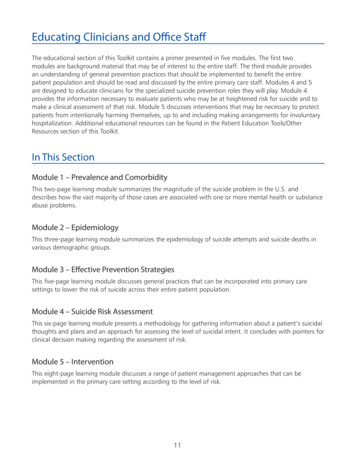
![firearms qualifications [PFP#730045656]](/img/59/firearms2003.jpg)

